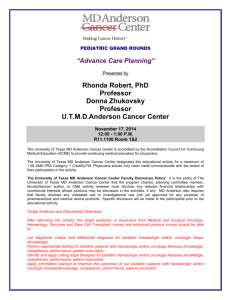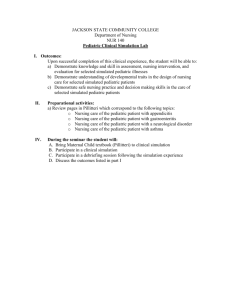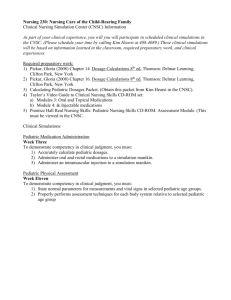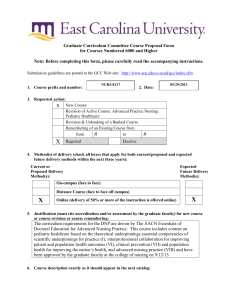Intro to Pediatric Hematologic Disorders MLP English
advertisement
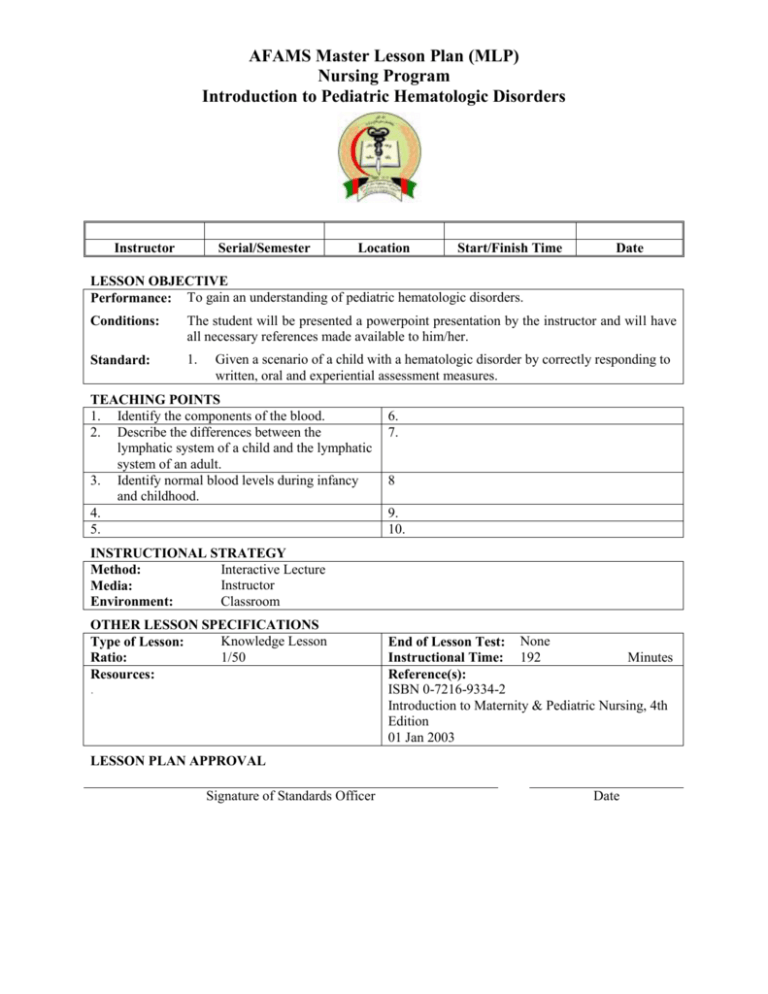
AFAMS Master Lesson Plan (MLP) Nursing Program Introduction to Pediatric Hematologic Disorders Instructor Serial/Semester Location Start/Finish Time Date LESSON OBJECTIVE Performance: To gain an understanding of pediatric hematologic disorders. Conditions: The student will be presented a powerpoint presentation by the instructor and will have all necessary references made available to him/her. Standard: 1. Given a scenario of a child with a hematologic disorder by correctly responding to written, oral and experiential assessment measures. TEACHING POINTS 1. Identify the components of the blood. 2. Describe the differences between the lymphatic system of a child and the lymphatic system of an adult. 3. Identify normal blood levels during infancy and childhood. 4. 5. 6. 7. 8 9. 10. INSTRUCTIONAL STRATEGY Interactive Lecture Method: Instructor Media: Classroom Environment: OTHER LESSON SPECIFICATIONS Knowledge Lesson Type of Lesson: 1/50 Ratio: Resources: . End of Lesson Test: None Minutes Instructional Time: 192 Reference(s): ISBN 0-7216-9334-2 Introduction to Maternity & Pediatric Nursing, 4th Edition 01 Jan 2003 LESSON PLAN APPROVAL Signature of Standards Officer Date AFAMS Master Lesson Plan (MLP) Nursing Program Introduction to Pediatric Hematologic Disorders INTRODUCTION Allocated Time: Review: 5 Minutes You have had previous anatomy and physiology lectures in your combat medic training, this lecture will build upon prior instruction. Objective: To discuss/describe topics related to the nursing process. Importance: Nurses work in various health care settings so it is important to gain an understanding of this subject as it will apply to your clinical practice. Fit: Blood and blood forming organs make up the hematological and immunological system. In order to understand the hematologic and immunologic disorders of the pediatric patient, we must understand their hematological system. During the next half hour we will discuss these systems and how children differ from adults. Approach: You will be presented the subject in lecture format and will be tested using a written exam at a later date. Control Statement: If you have any questions during the lesson please feel free to ask. BODY 1. Teaching Point: Identify the components of the blood. Minutes Allocated Time: Introduction: Learner Participation: Knowledge Lesson Please follow along with your hand outs and take notes. Skill Lesson Powerpoint presentation with associated handouts. Learning Support: a. Circulating blood consists of two portions: (1) Plasma. (2) Formed elements. (a) Erythrocytes- transport oxygen and carbon dioxide. (b) Leukocytes- defense against infections. 1) Granular- basophils, neutrophils, eosinophils. 2) Nongranular- lymphocytes, monocytes. (c) Thrombocytes- along with plasma responsible for blood coagulation. Platelets. b. Formation of blood. 1 AFAMS Master Lesson Plan (MLP) Nursing Program Introduction to Pediatric Hematologic Disorders (1) During childhood RBCs are formed in the marrow of the long bones (tibia and femur). (2) By adolescence hematopoesis takes place in every available space of the marrow of the ribs, sternum, vertebrae, pelvis, skull, clavicle and scapula. (3) Erythropoietin (produced in the liver of the fetus and the kidneys after birth) regulates the production of blood. (4) Lymphatic system- drains regions of the body to lymph nodes, where organisms are destroyed and antibody production is stimulated. (a) Lymphocytes. 1) Produced in the lymphoid tissue. 2) Mainly found in lymph tissues. 3) Fight infection. (b) Lymphatic vessels. (c) Lymph nodes. (d) Spleen. 1) Largest organ in the lymphatic system. 2) Main function is to bring blood into contact with lymphocytes. 3) Enlarges during infection, hemolytic anemias and liver malfunction. (e) Tonsils, adenoids, and thymus gland. Knowledge Lesson: Question: Answer: Check on Learning In a knowledge lesson, pose questions to the class. What are the three formed elements of blood? Erythrocytes, leukocytes and thrombocytes. Skill Lesson: In a skill lesson, provide practice and watch students perform a skill. 2. Teaching Point: Describe the differences between the lymphatic system of a child and the lymphatic system of an adult. Minutes Allocated Time: Introduction: Learner Participation: Knowledge Lesson Please follow along with your hand outs and take notes. Skill Lesson 2 AFAMS Master Lesson Plan (MLP) Nursing Program Introduction to Pediatric Hematologic Disorders Learning Support: Powerpoint presentation with associated handouts. a. Enlarged tonsils and adenoids are normal in preschool and school age children and is one of the body's defense mechanisms. b. Thymus gland is important in the development of immune response in newborns. c. Preterm and term infants are at greater risk for viral and bacterial infections because of immature Tcell activity. Knowledge Lesson: Question: Answer: Check on Learning In a knowledge lesson, pose questions to the class. Which gland is important in the development of the immune response? Thymus gland. Skill Lesson: In a skill lesson, provide practice and watch students perform a skill. 3. Teaching Point: Identify normal blood levels during infancy and childhood. Minutes Allocated Time: Introduction: Learner Participation: Knowledge Lesson Please follow along with your hand outs and take notes. Skill Lesson Powerpoint presentation with associated handouts. Learning Support: Age Neonate 3 months 6 months6 years 7-12 years Adult RBCs(g/dl) 16.5 12 HCT (%) 50 36 12 WBC/mm3 12,000 12,000 Neutrophils (%) 40 30 Lymphocytes (%) 63 48 Eosinophils (%) 3 2 Monocytes (%) 9 5 37 10,000 45 48 2 5 13 38 8-10,000 55 38 2 5 14-16 4247 8-10,000 55 35 3 7 Knowledge Lesson: Question: Answer: Check on Learning In a knowledge lesson, pose questions to the class. What is the normal hematocrit for a school age child? 38% Skill Lesson: In a skill lesson, provide practice and watch students perform a skill. 3 AFAMS Master Lesson Plan (MLP) Nursing Program Introduction to Pediatric Hematologic Disorders END OF LESSON TEST Allocated Time: Instructions: Test Questions or Performance Expected: Test Key: 0 Minutes You will be tested on this subject at a later date. You will be expected to review and study the material taught in this session in order to pass the associated written test. If you have difficulty with the material please see me so we can review together. None. CONCLUSION Allocated Time: Summary: 5 Minutes Review and re-emphasize the difficult Teaching Points below. 1. 2. 3. 4. 5. 6. 7. 8 9. 10. Identify the components of the blood. Describe the differences between the lymphatic system of a child and the lymphatic system of an adult. Identify normal blood levels during infancy and childhood. Closing Statement: Nurses work in various health care settings so it is important to gain an understanding of this subject as it will apply to your clinical practice. Re-motivating Statement: Blood and blood forming organs make up the hematological and immunological system. In order to understand the hematologic and immunologic disorders of the pediatric patient, we must understand their hematological system. During the next half hour we will discuss these systems and how children differ from adults. 4

